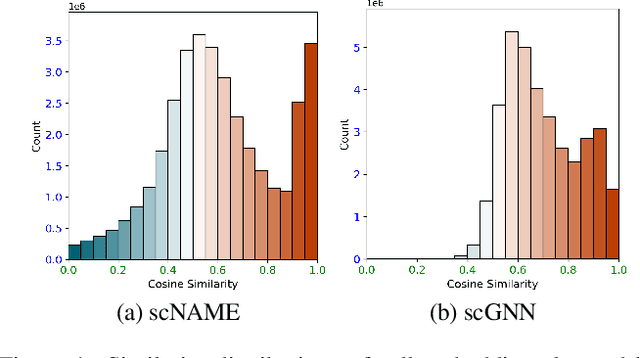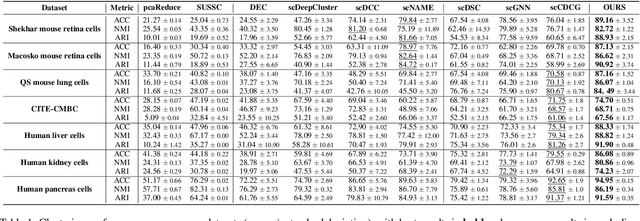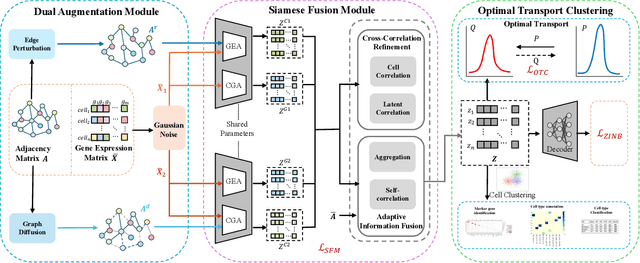Pengyang Wang
S$^4$C: Speculative Sampling with Syntactic and Semantic Coherence for Efficient Inference of Large Language Models
Jun 17, 2025Abstract:Large language models (LLMs) exhibit remarkable reasoning capabilities across diverse downstream tasks. However, their autoregressive nature leads to substantial inference latency, posing challenges for real-time applications. Speculative sampling mitigates this issue by introducing a drafting phase followed by a parallel validation phase, enabling faster token generation and verification. Existing approaches, however, overlook the inherent coherence in text generation, limiting their efficiency. To address this gap, we propose a Speculative Sampling with Syntactic and Semantic Coherence (S$^4$C) framework, which extends speculative sampling by leveraging multi-head drafting for rapid token generation and a continuous verification tree for efficient candidate validation and feature reuse. Experimental results demonstrate that S$^4$C surpasses baseline methods across mainstream tasks, offering enhanced efficiency, parallelism, and the ability to generate more valid tokens with fewer computational resources. On Spec-bench benchmarks, S$^4$C achieves an acceleration ratio of 2.26x-2.60x, outperforming state-of-the-art methods.
GCAL: Adapting Graph Models to Evolving Domain Shifts
May 22, 2025Abstract:This paper addresses the challenge of graph domain adaptation on evolving, multiple out-of-distribution (OOD) graphs. Conventional graph domain adaptation methods are confined to single-step adaptation, making them ineffective in handling continuous domain shifts and prone to catastrophic forgetting. This paper introduces the Graph Continual Adaptive Learning (GCAL) method, designed to enhance model sustainability and adaptability across various graph domains. GCAL employs a bilevel optimization strategy. The "adapt" phase uses an information maximization approach to fine-tune the model with new graph domains while re-adapting past memories to mitigate forgetting. Concurrently, the "generate memory" phase, guided by a theoretical lower bound derived from information bottleneck theory, involves a variational memory graph generation module to condense original graphs into memories. Extensive experimental evaluations demonstrate that GCAL substantially outperforms existing methods in terms of adaptability and knowledge retention.
Disentangled Multi-span Evolutionary Network against Temporal Knowledge Graph Reasoning
May 20, 2025Abstract:Temporal Knowledge Graphs (TKGs), as an extension of static Knowledge Graphs (KGs), incorporate the temporal feature to express the transience of knowledge by describing when facts occur. TKG extrapolation aims to infer possible future facts based on known history, which has garnered significant attention in recent years. Some existing methods treat TKG as a sequence of independent subgraphs to model temporal evolution patterns, demonstrating impressive reasoning performance. However, they still have limitations: 1) In modeling subgraph semantic evolution, they usually neglect the internal structural interactions between subgraphs, which are actually crucial for encoding TKGs. 2) They overlook the potential smooth features that do not lead to semantic changes, which should be distinguished from the semantic evolution process. Therefore, we propose a novel Disentangled Multi-span Evolutionary Network (DiMNet) for TKG reasoning. Specifically, we design a multi-span evolution strategy that captures local neighbor features while perceiving historical neighbor semantic information, thus enabling internal interactions between subgraphs during the evolution process. To maximize the capture of semantic change patterns, we design a disentangle component that adaptively separates nodes' active and stable features, used to dynamically control the influence of historical semantics on future evolution. Extensive experiments conducted on four real-world TKG datasets show that DiMNet demonstrates substantial performance in TKG reasoning, and outperforms the state-of-the-art up to 22.7% in MRR.
scSiameseClu: A Siamese Clustering Framework for Interpreting single-cell RNA Sequencing Data
May 19, 2025



Abstract:Single-cell RNA sequencing (scRNA-seq) reveals cell heterogeneity, with cell clustering playing a key role in identifying cell types and marker genes. Recent advances, especially graph neural networks (GNNs)-based methods, have significantly improved clustering performance. However, the analysis of scRNA-seq data remains challenging due to noise, sparsity, and high dimensionality. Compounding these challenges, GNNs often suffer from over-smoothing, limiting their ability to capture complex biological information. In response, we propose scSiameseClu, a novel Siamese Clustering framework for interpreting single-cell RNA-seq data, comprising of 3 key steps: (1) Dual Augmentation Module, which applies biologically informed perturbations to the gene expression matrix and cell graph relationships to enhance representation robustness; (2) Siamese Fusion Module, which combines cross-correlation refinement and adaptive information fusion to capture complex cellular relationships while mitigating over-smoothing; and (3) Optimal Transport Clustering, which utilizes Sinkhorn distance to efficiently align cluster assignments with predefined proportions while maintaining balance. Comprehensive evaluations on seven real-world datasets demonstrate that~\methodname~outperforms state-of-the-art methods in single-cell clustering, cell type annotation, and cell type classification, providing a powerful tool for scRNA-seq data interpretation.
Rethinking Graph Contrastive Learning through Relative Similarity Preservation
May 08, 2025Abstract:Graph contrastive learning (GCL) has achieved remarkable success by following the computer vision paradigm of preserving absolute similarity between augmented views. However, this approach faces fundamental challenges in graphs due to their discrete, non-Euclidean nature -- view generation often breaks semantic validity and similarity verification becomes unreliable. Through analyzing 11 real-world graphs, we discover a universal pattern transcending the homophily-heterophily dichotomy: label consistency systematically diminishes as structural distance increases, manifesting as smooth decay in homophily graphs and oscillatory decay in heterophily graphs. We establish theoretical guarantees for this pattern through random walk theory, proving label distribution convergence and characterizing the mechanisms behind different decay behaviors. This discovery reveals that graphs naturally encode relative similarity patterns, where structurally closer nodes exhibit collectively stronger semantic relationships. Leveraging this insight, we propose RELGCL, a novel GCL framework with complementary pairwise and listwise implementations that preserve these inherent patterns through collective similarity objectives. Extensive experiments demonstrate that our method consistently outperforms 20 existing approaches across both homophily and heterophily graphs, validating the effectiveness of leveraging natural relative similarity over artificial absolute similarity.
Deep Cut-informed Graph Embedding and Clustering
Mar 09, 2025Abstract:Graph clustering aims to divide the graph into different clusters. The recently emerging deep graph clustering approaches are largely built on graph neural networks (GNN). However, GNN is designed for general graph encoding and there is a common issue of representation collapse in existing GNN-based deep graph clustering algorithms. We attribute two main reasons for such issue: (i) the inductive bias of GNN models: GNNs tend to generate similar representations for proximal nodes. Since graphs often contain a non-negligible amount of inter-cluster links, the bias results in error message passing and leads to biased clustering; (ii) the clustering guided loss function: most traditional approaches strive to make all samples closer to pre-learned cluster centers, which cause a degenerate solution assigning all data points to a single label thus make all samples and less discriminative. To address these challenges, we investigate graph clustering from a graph cut perspective and propose an innovative and non-GNN-based Deep Cut-informed Graph embedding and Clustering framework, namely DCGC. This framework includes two modules: (i) cut-informed graph encoding; (ii) self-supervised graph clustering via optimal transport. For the encoding module, we derive a cut-informed graph embedding objective to fuse graph structure and attributes by minimizing their joint normalized cut. For the clustering module, we utilize the optimal transport theory to obtain the clustering assignments, which can balance the guidance of proximity to the pre-learned cluster center. With the above two tailored designs, DCGC is more suitable for the graph clustering task, which can effectively alleviate the problem of representation collapse and achieve better performance. We conduct extensive experiments to demonstrate that our method is simple but effective compared with benchmarks.
Towards Data-Centric AI: A Comprehensive Survey of Traditional, Reinforcement, and Generative Approaches for Tabular Data Transformation
Jan 17, 2025



Abstract:Tabular data is one of the most widely used formats across industries, driving critical applications in areas such as finance, healthcare, and marketing. In the era of data-centric AI, improving data quality and representation has become essential for enhancing model performance, particularly in applications centered around tabular data. This survey examines the key aspects of tabular data-centric AI, emphasizing feature selection and feature generation as essential techniques for data space refinement. We provide a systematic review of feature selection methods, which identify and retain the most relevant data attributes, and feature generation approaches, which create new features to simplify the capture of complex data patterns. This survey offers a comprehensive overview of current methodologies through an analysis of recent advancements, practical applications, and the strengths and limitations of these techniques. Finally, we outline open challenges and suggest future perspectives to inspire continued innovation in this field.
BackdoorMBTI: A Backdoor Learning Multimodal Benchmark Tool Kit for Backdoor Defense Evaluation
Nov 17, 2024



Abstract:We introduce BackdoorMBTI, the first backdoor learning toolkit and benchmark designed for multimodal evaluation across three representative modalities from eleven commonly used datasets. BackdoorMBTI provides a systematic backdoor learning pipeline, encompassing data processing, data poisoning, backdoor training, and evaluation. The generated poison datasets and backdoor models enable detailed evaluation of backdoor defense methods. Given the diversity of modalities, BackdoorMBTI facilitates systematic evaluation across different data types. Furthermore, BackdoorMBTI offers a standardized approach to handling practical factors in backdoor learning, such as issues related to data quality and erroneous labels. We anticipate that BackdoorMBTI will expedite future research in backdoor defense methods within a multimodal context. Code is available at https://anonymous.4open.science/r/BackdoorMBTI-D6A1/README.md.
Is Precise Recovery Necessary? A Task-Oriented Imputation Approach for Time Series Forecasting on Variable Subset
Nov 15, 2024



Abstract:Variable Subset Forecasting (VSF) refers to a unique scenario in multivariate time series forecasting, where available variables in the inference phase are only a subset of the variables in the training phase. VSF presents significant challenges as the entire time series may be missing, and neither inter- nor intra-variable correlations persist. Such conditions impede the effectiveness of traditional imputation methods, primarily focusing on filling in individual missing data points. Inspired by the principle of feature engineering that not all variables contribute positively to forecasting, we propose Task-Oriented Imputation for VSF (TOI-VSF), a novel framework shifts the focus from accurate data recovery to directly support the downstream forecasting task. TOI-VSF incorporates a self-supervised imputation module, agnostic to the forecasting model, designed to fill in missing variables while preserving the vital characteristics and temporal patterns of time series data. Additionally, we implement a joint learning strategy for imputation and forecasting, ensuring that the imputation process is directly aligned with and beneficial to the forecasting objective. Extensive experiments across four datasets demonstrate the superiority of TOI-VSF, outperforming baseline methods by $15\%$ on average.
DyGKT: Dynamic Graph Learning for Knowledge Tracing
Jul 30, 2024



Abstract:Knowledge Tracing aims to assess student learning states by predicting their performance in answering questions. Different from the existing research which utilizes fixed-length learning sequence to obtain the student states and regards KT as a static problem, this work is motivated by three dynamical characteristics: 1) The scales of students answering records are constantly growing; 2) The semantics of time intervals between the records vary; 3) The relationships between students, questions and concepts are evolving. The three dynamical characteristics above contain the great potential to revolutionize the existing knowledge tracing methods. Along this line, we propose a Dynamic Graph-based Knowledge Tracing model, namely DyGKT. In particular, a continuous-time dynamic question-answering graph for knowledge tracing is constructed to deal with the infinitely growing answering behaviors, and it is worth mentioning that it is the first time dynamic graph learning technology is used in this field. Then, a dual time encoder is proposed to capture long-term and short-term semantics among the different time intervals. Finally, a multiset indicator is utilized to model the evolving relationships between students, questions, and concepts via the graph structural feature. Numerous experiments are conducted on five real-world datasets, and the results demonstrate the superiority of our model. All the used resources are publicly available at https://github.com/PengLinzhi/DyGKT.
 Add to Chrome
Add to Chrome Add to Firefox
Add to Firefox Add to Edge
Add to Edge